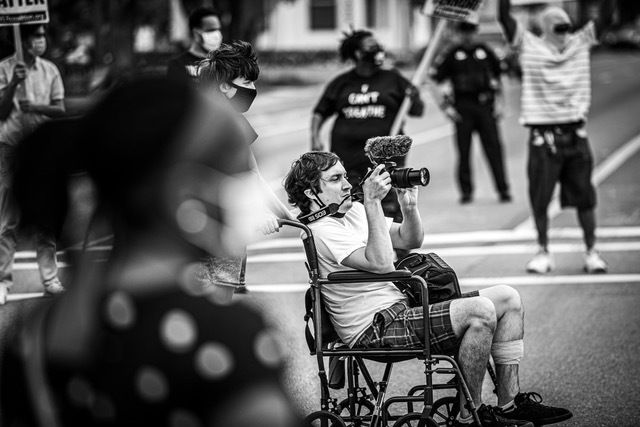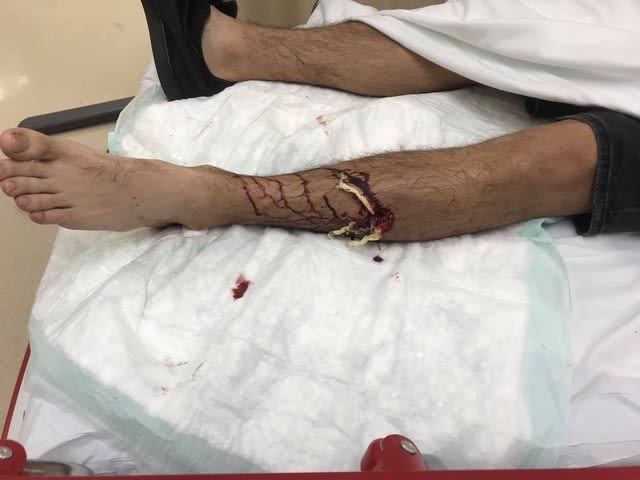How Safe Are Bean Bag 'Bullets'?

Bryan Ellis at a protest in a wheelchair after he was shot in the leg with a bean bag.
Image: Allan Mestel Photography
Bryan Ellis turned and fled after Tampa police fired tear gas and bean bag rounds into a crowd of a couple hundred Black Lives Matter protestors on Sunday, May 31. He felt something hit his left calf. “I just thought, ‘Wow, that hurts a lot,’” Ellis remembers. He hobbled his way behind a van at a corner gas station to take shelter and looked down at his leg. Protesters around him shouted, “You got shot!” The bean bag had disappeared inside his leg. “I was shocked. Blood was spurting out,” Ellis said.
Ellis’s injury is not unique. As confrontations between police and protesters have mounted across the country, use of “less lethal” weapons by the police have caused severe and permanent damage to peaceful protesters. Brandon Saenz of Dallas, Texas, was shot in the face with a rubber bullet on May 30 and lost his eye. Indiana journalist Balin Blake was struck in the head by a tear gas canister on May 31 at a protest in Fort Wayne, Indiana, and also lost an eye. Freelance photographer Linda Tirado was shot by a rubber bullet on May 29 and blinded in one eye at a street protest in Minneapolis. Sixteen-year-old Levi Ayala was shot in the head on May 30 with a bean bag round in Austin, Texas. The bag lodged into his forehead and he may be permanently disabled.
By Florida statute, law enforcement agencies do not need to tell the public what is in their arsenal, and the Sarasota County Sheriff’s Office would not reveal any information about weapons, including the “less lethal” options deputies use. Bradenton Police Department Assistant Chief of Police Paul McWade says his department does not use rubber bullets or bean bags (neither does the Sarasota Police Department), but does use “foam rounds” that are only allowed to be fired at the stomach and legs. They’re more precise and, he says, less damaging. “They’re more like a knock-down,” he says.
Law enforcement agencies do not list their weaponry “because you don’t want the bad guys to know what you have,” McCabe adds. People might wear shin guards, for example, if they know police shoot for the legs, he says.
Ellis, 33, a Sarasota legal assistant, doesn’t see himself as a bad guy, but he is a seasoned protester and works with local organizations fighting against police brutality, such as in the case of Rodney Mitchell, a Sarasota resident who was killed by Sarasota County Sheriff’s deputies in 2012 when he was stopped for a traffic violation.
On May 31, Ellis drove up to Tampa to film the protest for an organization and walk with several different groups all marching in the streets under the banner of ending police brutality in the aftermath of the George Floyd killing. Hundreds of people gathered in downtown Tampa and marched for hours in the mid-afternoon heat, he said. By 5 p.m., many of the protesters had gone home, but a few hundred stayed and continued marching toward Memorial Park Cemetery at Martin Luther King Jr. Boulevard E. and N. 22nd Street.
“We were rallying at the intersection,” Ellis said. “It was very inspiring. The energy was high, people were dancing, it was nonviolent.” The regular police had helped block off the intersection to divert traffic from the protesters. Then dozens of Tampa riot police arrived. “It enraged everyone,” Ellis said. “We all asked, ‘Why are you here?’”
Tampa mayor Jane Castor had set a curfew of 7:30 p.m. because of the previous night’s destructive protests. But according to Ellis, it wasn’t even 6 p.m. when protesters came face to face with riot police. Tensions mounted. A police loudspeaker announced that the assembly was unlawful and that protesters would be arrested and subject to actions, including "less lethal munitions." Then someone threw what appeared to be a water bottle into the police phalanx. Within seconds, the police began shooting at the protesters.
“The crowd ran away and moved back,” Ellis said. “Then they began to ebb back into the intersection, but with greater caution.”
Ellis filmed the protesters returning to the street with their hands raised in the air, holding signs and getting down on their knees in the intersection. A canister emitting red smoke landed near Ellis. A protester picked up the canister and threw it toward the police. That’s when Ellis got shot.
A circle formed around him; all Ellis remembers is a tall black man carrying him “like a big baby” to a nearby vehicle where he was driven to Tampa General Hospital, about 20 minutes away. Ellis spent the next four hours in the hospital where a doctor removed the bean bag round and let him keep it as a souvenir. He was tested for COVID-19, discharged and given the same pamphlet that the hospital gives to a gunshot wound victim.


Ellis spent four hours in the hospital, where a doctor removed the bean bag round and let him keep it as a souvenir. He was tested for COVID-19, discharged and given the same pamphlet that the hospital gives to a gunshot wound victim.
Image: Courtesy Photo
“I haven’t received the bill yet, but it’s supposed to be a few thousand dollars,” Ellis said. He reached out to the ACLU and they told him he has no legal recourse. “Basically, you go to a peaceful protest, the police shoot you, and that’s life,” he said.
According to officer.com, a website for law enforcement with information on police technology, a bean bag round “is a small fabric pillow that is filled with No. 9 lead shot that weighs about 1.4 ounces. It is usually fired from a 12-gauge shotgun and expelled about 250 to 300 feet per second. It spreads out in flight and distributes its impact over one square inch of the target.” The website goes onto to explain that this ammunition will not cause penetration to the body and is designed only for minimum “long-term trauma.”
The bean bag round penetrated two inches into Ellis’s leg. Two weeks later, Ellis’s leg still hurts, and he’s having trouble sleeping.
“I had a big personal awakening,” he said. “My whole concept around the 'less lethal' projectiles has changed. The bean bag round is fired out of a real shotgun. I thought they were supposed to bounce off you and leave a bruise. But these are lethal projectiles.”
In the meantime, Ellis is still protesting. At last week’s local Sarasota protests, friends pushed him around in a wheelchair, and he plans on going to more still. “This is definitely historic. We’ve hit some sort of tipping point. Everybody is getting involved,” he says.



